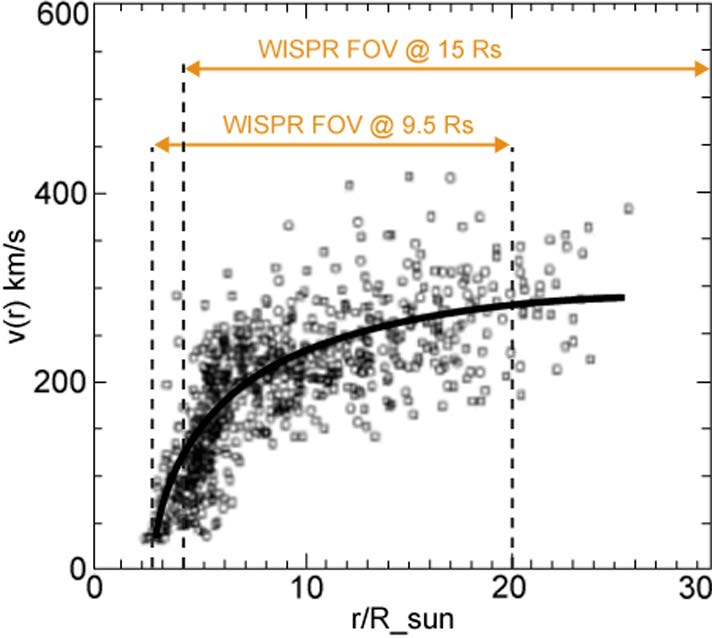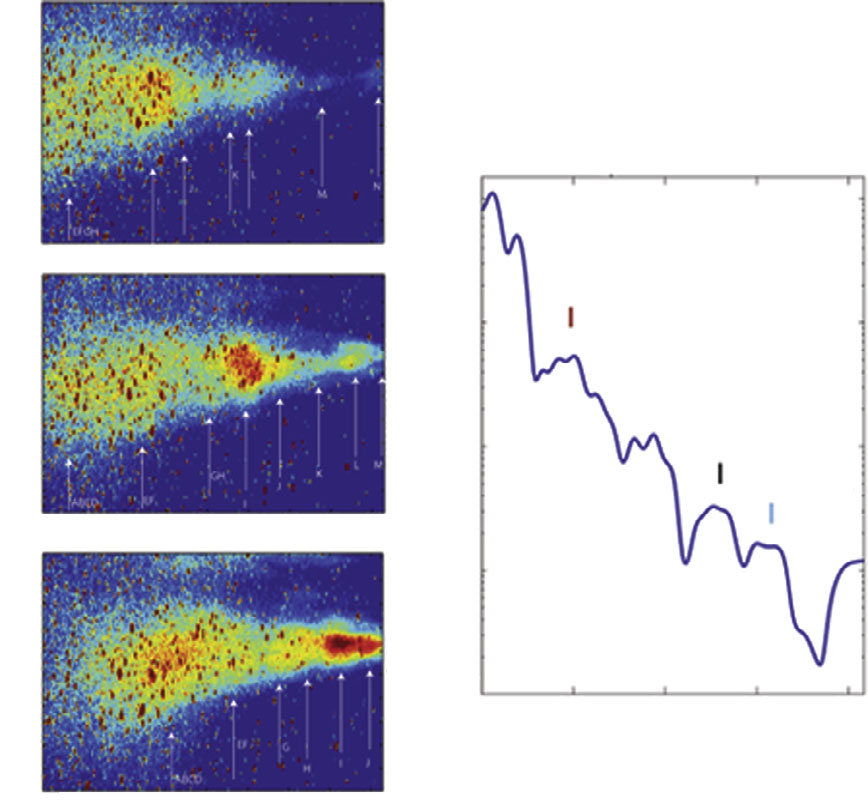‘How do the observed structures in the corona evolve into the solar wind?’
(As discussed in Question 1) Streamers are expected to be the source of the slow solar wind. How they provide this slow wind, however, has not yet been proven, though a number of models of slow solar wind acceleration have been proposed. For example, the models and simulations presented by Einaudi et al. (1999, 2001) show that the slow solar wind can be accelerated in streamers via coupling to the fast solar wind on either side of the streamer current sheet. Tearing modes and Kelvin-Helmholtz modes in the streamer create islands, which are then accelerated by the nearby fast wind (see, e.g., Rappazzo et al. 2005). Antiochos et al. (2007), on the other hand, suggest that the slow solar wind may be accelerated by continuous small-scale reconnection events, which occur between closed and open magnetic fields at the boundaries of coronal holes. WISPR will look for signatures of these mechanisms by observing and characterizing structures, which are ejected into the solar wind from streamer current sheets.
White-light imaging with the LASCO coronagraphs has revealed a variety of such dynamical phenomena within the HPS in the outer corona, including plasma blobs that are ejected continually from the cusps of streamers (Sheeley et al. 1997; Wang et al. 1999b; Wang and Sheeley 2006), ray-like structures pervading the streamer belt (Thernisien and Howard 2006), and swarms of small-scale inflows (Wang et al. 1999a; Sheeley and Wang 2001) that occur during times of high solar activity (Fig. 4). The helmet streamers in which these structures are created comprise open field lines lying over closed magnetic loops. Reconnection between open and closed magnetic field lines (Antiochos et al. 2007; interchange reconnection: Crooker et al. 2004; Zurbuchen et al. 2002), between closed magnetic fields lines (generating helical fields) and between open field lines of opposite polarities (Einaudi et al. 1999; Wang et al. 2007; Linton et al. 2009) have all been invoked as the different mechanisms which could trigger the formation and release of such streamer blobs. In addition to serving as a potential source of the slow solar wind, these reconnection processes have a bearing on questions as diverse as the formation and evolution of the HPS/HCS, the heliospheric magnetic flux budget, the solar-cycle evolution of the coronal field, and the rigid rotation of coronal holes. To investigate these phenomena and to test slow solar wind models, we need detailed velocity profiles using high cadence WISPR measurements of streamer outflows, correlated with the in-situ measurements. WISPR observations are essential for studying reconnection in the high corona by providing the 3D location and morphology of streamer ejections and measurements of their evolution before the SPP in-situ payload intercepts them.
To study the details of these small-scale transients, we need high-resolution observations, as these transients commonly take up only a few pixels in current LASCO and SECCHI coronagraph observations (Sheeley et al. 2008; Rouillard et al. 2008, 2009). WISPR is designed with a 6.4 arcmin resolution so that it can image and trace the streamer blobs, within its FOV, to large heights and with a resolution equivalent to or better than that of the LASCO or SECCHI coronagraphs. The increased resolution and sensitivity of WISPR due to the much smaller contribution of the F-corona brightness (Sect. 1.4) will reduce the scatter in the outer velocity measurements. With the combined WISPR and in-situ measurements, we will determine how the slow solar wind densities and speeds vary across the streamer and how that depends on the current sheet structure. WISPR’s wide FOV enables the measurement of the true velocity and acceleration profiles of the transient slow solar wind flows and determine accurately the mass flux contriThe Wide-Field Imager for Solar Probe Plus (WISPR) bution of blobs and other ejections to the solar wind. This will provide, for the first time, quantitative tests of the various theoretical models, which explain the origin of the slow solar wind. We will be able to determine if the slow wind is accelerated by viscous coupling to the fast wind just outside the streamer, if it is self-accelerated by turbulence and reconnection within the streamer or if it is accelerated by reconnection in the corona at the boundary between the streamers and coronal holes. The determination of the local structure of the solar wind as it correlates with the streamer observations is only the first step in understanding the full solar wind geometry. These measurements must then be combined with high-resolution tomographic reconstructions of the transient features, which originate in streamers. This will vastly improve our ability to determine the location, size and propagation direction of these streamer transients. By following the evolution of these transients, we will be able to determine the 3D flows and mass fluxes around streamers and the degree to which these flows are non-radial below the sonic point. Combining these WISPR remote observations with the in-situ observations will give us the exciting new capability to reconstruct a significant part of the slow solar wind outflow, providing new insights into the structure of the corona and key inputs for models of coronal fields and solar wind acceleration.
In-situ observations reveal significant fine-scale structure within the fast solar wind which led Feldman et al. (1996) to surmise that these structures are remnants of reconnection events back in the solar corona (e.g., jets, spicules). However, the origin of these fast solar wind structures is unknown because line-of-sight effects and the reduced density within coronal holes hinder the imaging of the fine scale structures from 1 AU, especially for equatorial coronal holes. The proximity of the SPP orbit to the solar corona essentially removes the effects of the F-corona and reduces the number of overlapping structures along the line of sight (LOS) (Sect. 1.4). It provides a unique opportunity to detect and image the faint plasma within coronal holes. WISPR will be able to image this plasma from both equatorial and polar coronal holes up to a heliolatitude of ∼40◦ or higher depending on the solar B angle. WISPR will detect the plumes with higher contrast and spatial resolution than has ever been possible. It will measure the plume/interplume density variations and determine the presence of fine scale structure within coronal holes, thus allowing precise measurements of the contribution of plumes and interplume regions to the observed fast wind mass flux. WISPR will be able to image the fast wind for the first time and track such blobs, if they exist, within polar plumes. WISPR will provide these crucial observations over a significant part of the solar cycle. Hence, we will obtain the first detailed measurements of the fast wind acceleration profile over large areas of the corona and, with the addition of the SPP in-situ data, provide important constraints for testing theories of fast solar wind acceleration. Together with the slow solar wind observations discussed above, these studies will form comprehensive sets of observations, which will substantially improve our understanding of the sources of the slow and fast solar wind. These measurements will be invaluable as initial condition inputs to the real-time large-scale heliospheric models such as ENLIL and will lead to improved forecasting for space weather conditions at Earth and other planets. On larger scales, the solar wind flow is disrupted by CMEs. WISPR will contribute to CME studies in two ways. First, the high-resolution WISPR tomographic images will allow us to recreate the 3D structure within CMEs. Second, when combined with in-situ measurements of magnetic field and plasma properties, the WISPR observations will allow us to determine the physical state of the ejected CME plasma (thermal, magnetic and kinetic) right at the initial boundary of most CME propagation models (e.g., ENLIL) which will greatly enhance their performance and improve forecasting capabilities. In addition, most

LASCO speed measurements of streamer blobs. The WISPR fields of view for two perihelia are also shown.

Periodicities in the solar wind density derive from SECCHI/HI observations. Left: Tracing of individual density blobs within a streamer from 15 to 60 Rs. Right: The derived periodicities of 5 h.
